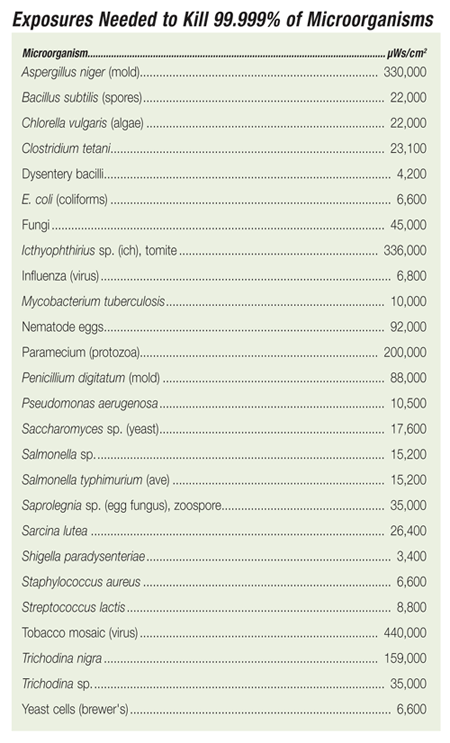
Aqua Ultraviolet UV Sterilizer
Choosing a UV Sterilizer
Sometimes referred to as clarifiers or sanitizers, UV sterilizers provide much more than just algae control.
Take the time to size a UV properly, or your money will be wasted.
UV sterilizers can be useful, but only if sized correctly. You can't put a 9w sterilizer on a 100g tank and expect it to be useful to kill off Ich. So how do you know what size UV sterilizer it'd take?
Basics
Ich (or any other microorganism) is killed by UV because the UV breaks down the cell wall and then the DNA within the cells. This is exactly the same process that you get a sunburn – exposure to UV. And in exactly the same way, you sunburn only when the duration and intensity is long enough – running out to the mailbox isn't enough, but lying on the beach in the middle of summer on a clear day for 6 hours would fry most of us to a crisp. Likewise, Ich has to be exposed to a certain amount of UV before it's killed.
UV Radiation
Intensity is measured in micro-watts of energy per second over a certain area (square centimeter): uWs/cm2 (ref). Marine Ich is in the genus Ichthyophthirus, and the tomites are the free-swimming stage of the Ich organism and the one that's susceptible to UV sterilization (ref). Using the chart below, we see that the amount of radiation to kill Ich in this stage is 336,000 uWs/cm2 – one of the highest on the chart.
So… 336,000 uWs/cm2 will be our target- if we can kill Ich, we can kill algae or anything else that comes through the UV.
UV Sterilizer Ratings
Now we'd need to put this in practice. Any decent UV sterilizer manufacturer should publish the exposure rate for their product, ideally in saltwater. Some manufacturers even publish the rate at different flow rates, which is most accurate. For example, see page two of Aqua UV's manual.
I would highly recommend NOT buying a UV sterilizer from a company that does not publish this number. This would be the same as buying a pump without knowing the gph ratings…
Putting it all together
So now it's time to do a little math. Let's choose the Aqua UV 80 watt sterilizer. Based on that chart, it's rated for 90,000 uW/cm2 @ 1226gph. Note that the radiation goes down when the flow goes up- this makes sense, since the water is going through faster and simply doesn't get exposed to as much radiation.
If you do the math, you'll see that it's linear – if you push the water through twice as fast, you'll get about half as much radiation. (Again, if you're on the beach for 3 hours instead of 6 hours, you get half as much UV radiation, and you're not quite as lobster-ish at the end of the day.)
So… we can divide it out. To get 336,000 uWs/cm2 from 90,000 uWs/cm2, we'd need to slow down the water by (336 / 90) = 4. So take that 1226gph rating, divide it by 4, and we get 306gph for that sterilizer. It'd be nice if the manufacturers created another column to show this, but the math will get us there….
Sizing for your tank
So, now we have our gph rating for the sterilizer. But is this enough? If you have a 100g system, is 50gph through the UV enough? What kind of flow through the UV sterilizer should we have for a certain size system?
This part gets a little fuzzy, and I haven't been able to find concrete numbers. I tend to recommend the 1x turnover rule – if you have a 100g system, then find a UV sterilizer that you can run at 100gph to reach the 336,000 uWs/cm2 target.
If someone can find some quantifiable numbers for this, then speak up, but I don't believe any research has been done. Anything less than the system volume once per hour seems too low; anything higher gets overly expensive.
Conclusion
– Not all sterilizers are rated the same. You must look at the radiation produced by a given sterilizer. To get the 336,000 target on Coralife's 36watt sterilizer brings us to 2.8 gph; to do the same on a 40w Aqua UV requires 241 gph (no – those are not mistypes!).
– Effective UV sterilization is not cheap. Sorry – there's no free lunch. Yes, you may be able to kill algae or something else in the water column, but you won't be killing Ich unless you reach the correct radiation.
– Be aware that companies tend to over-estimate their products. They're in the business to sell their product, not to kill your Ich. If they give a uWs/cm2 rating with a gph range, for example, rest assured that you need to use the most pessimistic numbers published. If they don't give a uWs/cm2 rating, then don't buy from them.
– Which company is best? I personally don't think that one is better than another – they all work on the same concept. Some are built better or have nicer features, but they all work on the same basic concept. Buy whatever fits into your budget and has the features you want.
– Based on the above, someone could come up with a chart that would show the units appropriate for a given tank size. It'd take some work, but it's doable.
Exposure Chart



